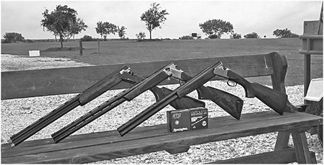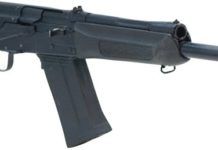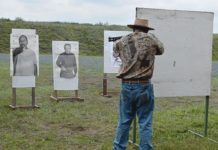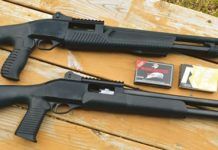
The menu for clay shooters and hunters looking to pick up a new over-and-under shotgun can range from plain meat-and-potatoes to chateaubriand. The scattergun choices that will fit each individual’s taste just became a little more varied with the introduction of the radical new Browning Cynergy, which is a bold new step for the veteran firearms company. We take a look at the new offering in the over-and-under arena and compare it to two other menu selections for the discerning shotgunner.
The recent introduction of the Browning Cynergy over and under is a radical departure from the Citori models introduced in recent years. The shotgun has caught the eye of shooters and shotgun enthusiasts across the country because of its new design and internal mechanical innovations.
Similar head-turning attention has been focused on the Beretta 686 Onyx Pro X-Tra Wood model, which has the appearance of a high-dollar custom creation while maintaining a low-budget price tag. The curls and swirls in the finish on the wood of the Beretta are some of the best-looking grain ever to grace a scattergun, giving the firearm a very attractive, showpiece appearance.
These two firearms have moved the over-and-under world onto a new plateau, with shooters standing in line to get a chance to put them through their paces.
To cover the range of over and unders on the market, we also put a Silma Deluxe Model 70EJ into our test group’s mix. The Silma is offered as an economy model over and under that will fit in the budget of most shooters, while providing some of the qualities of a pricier firearm.
To put our test shotguns through their paces on the sporting clays course, our test ammunition included Remington Premier STS Low Recoil 2.75-inch, 2.5 dram shells with 1 1/8 ounce of No. 8 shot with a muzzle velocity of 1,100 feet per second; Remington Premier STS Low Recoil 2.75-inch, 3.0 dram shells with 1 1/8 ounce of No. 7 1/2 shot with a muzzle velocity of 1,200 fps; and Estate Super Sport Competition Target Load 2.75-inch, 2.75 dram shells with 1 ounce of No. 8 shot with a muzzle velocity of 1,180 fps. Since the Browning would only handle 2.75-inch shells, no 3.5-inch shells were used in our test sessions.
Here’s our test report:
[PDFCAP(1)]
This gun is made in Japan and is distributed by Browning USA. It caused quite a few double takes when it was taken out of the box.
With its radically new stock that slopes forward at the comb and features an Inflex recoil pad, plus the low-profile receiver, this is a bold new step for the company founded by John M. Browning.
Although our test gun did have an unusual feel when first put to your shoulder, minor adjustments by the shooter quickly allowed for target-busting performance. Unfortunately, a drawback to the system is that installation of an after-market recoil reducer, a Jones Adjuster or even shortening the stock to fit a youngster or small shooter would be very difficult.
The Browning test gun was 47.0 inches in overall length, with a 30-inch factory-ported barrel and a length of pull of 14.5 inches.
Weighing 7.75 pounds, the shotgun was easy to handle, and the new-style recoil pad performed very well. The trigger pull was 5.25 pounds for the bottom barrel and 6 pounds for the top, and, as Browning advertises, produced a very crisp and fast operation.
An examination by our gunsmith confirmed that the mechanical trigger system is more similar to a rifle than a shotgun. The Reverse Striker design is an interesting innovation that reduces both lock time and overtravel. However, our gunsmith did express his concerns about the durability of the system, which will be determined after the firearms have been put to extensive use by target shooters. The additional stress points could pose a problem with potential metal failure, although no such problems have been reported to date.
The drop at the comb was 1.5 inches, with the drop at the heel of 2.4 inches. Length of pull was 14.5 inches, although three pad lengths are available that can alter the LOP by one-half inch increments and a quarter-inch spacer is included with the shotgun. Additional pads are available from Browning for about $35. These adjustable features are a big plus for the Cynergy.
Gun fit for our test group was very good with the pad already on the test gun, so additional adjustments were unnecessary.
Also adding to the Cynergy’s performance on the clay target field were the back-bored and ported barrels. Both recoil and muzzle jump were noticeably less than the other test guns and the glide factor (moving through targets at various speeds) was very pleasing.
With its 8-11 millimeter tapered rib, topped with a white bead middle sight and chartreuse HiViz Pro-Comp front sight, the pointing ability of the Cynergy earned high marks from our test group.
There were no malfunctions during any of the testing, and most of the testers were hesitant to stop shooting this fine firearm because of its handling ability.
[PDFCAP(2)]
This gun is made in Italy and is distributed by Beretta U.S.A. At first glance, the wood and forearm of the shotgun are absolutely gorgeous with incredible grain running in swirls and patterns throughout. However, on closer examination, a seam can be seen on the top of the stock where the finish has been applied.
During some point during the testing, a tiny chip in the finish was discovered on the top of the stock. Beretta does offer to redo the special waterproof finish, for a fee, if damage or excessive wear occurs. This should be factored in for someone interested in adding the shotgun to his shooting collection.
Our test gun measured 45.75 inches in overall length with a 28-inch barrel and a length of pull of 15.0 inches. The drop at the comb was 1.5 inches and the drop at the heel was 2.25 inches, providing a comfortable feel for all the members of our test group.
The easily removable Gel-Tek recoil pad (a spare hard rubber pad is included in the package) offered a very solid, non-slip grip for all of our test shooters. By pulling out the wire clip, the pad can be removed and the solid rubber pad can be added, which shortened the LOP about one-quarter inch — a nice touch for shooters who don’t fit the standard measurements.
The trigger pull of the Beretta was a crisp 4.5 pounds for the bottom barrel and 5.5 pounds for the top. Both provided pleasing operation and were safe and acceptable.
Although lighter than other test guns, the Beretta was well balanced and featured a little more muzzle weight to make handling the shotgun very smooth and uncomplicated.
A minor problem with the Beretta involved the Truglo Tru-Bead fiber optic front sight, which broke into two pieces during our testing. Replacement was quick and easy, but our testers were concerned about the durability of the sight.
As with the Cynergy, there were no malfunctions with any of the test ammunition and target breaks were very good with all loads.
[PDFCAP(3)]
This Italian product is imported by Legacy Sports International of Alexandria, Virginia. When one of the first comments of the test group was “This shotgun just feels clunky,” the prospects of the firearm receiving high marks appeared to be slim. When the shotgun failed to fire the second barrel on the third pair of shots, those prospects completely disappeared.
If the shooter pushed the barrel selector on the trigger, two shots could be fired, but the normal operation of firing one shot after another proved to be nearly impossible.
Checking the instruction manual included with the Silma did not provide much assistance. Under the title “HOW TU [sic] USE SINGLE SELECTIVE TRIGGER CORRECTLY,” were the statements: “Before pressing the pushbutton of the selector, control your gun is armed (open up the gun till its far end and then close it up again. Never act on the selector button when your gun has either a shot or even both shots are not armed. In case you should neglect and disobedy [sic] to the above mentioned instructions gund [sic] gears will not work properly and our guaranty will not cover any perspective damage anymore.”
We gave up on attempting to understand the instructions, and the shotgun was taken to a gunsmith, who disassembled the firearm and examined the internal mechanism. He determined that the inertia block was engaging the trigger, preventing the second shot from being fired. The repairs would have required about $80 worth of gunsmithing work, on a firearm right out of the box. When the shotgun could be fired at targets, the general balance and feel between the hands was marginal, prompting the “clunky” description.
Our test shotgun was 45 inches in overall length and weighed 7.5 pounds. The barrel length was 28 inches, with the drop at the comb of 1.5 inches and a drop at the heel of 2.5 inches. Length of pull was 14.75 inches. Recoil from the shotgun was greater than in the other two test firearms, with the thin, hard rubber recoil pad identified as part of the problem. In addition, the trigger pull was 7.25 pounds for the top barrel and 6 pounds for the bottom, with both exhibiting creep.
Another observation from the gunsmith when he was checking out the internal workings of the shotgun was that the metal parts of the forearm were attached to the wood with Phillip’s head screws. Because these type of screws can be easily stripped and don’t provide as much torque as straight head screws, their use is unusual.
Gun Tests Recommends
• Browning Cynergy Sporting Over and Under 12 Gauge, $2,690. Our Pick. While the jury may still be out on how the internal mechanism may hold up under heavy use, there is no question about the excellent handling ability and overall performance of this new entry into the shooting world.
• Beretta 686 Onyx Pro Series X-Tra Wood Over and Under 12 Gauge, $2,125. Buy It. A concern about how the finish of this fine firearm would hold up kept our test group from ranking this shotgun as our top pick. This is a very fine handling and shooting piece that would be a good choice for anyone looking for an all-around shotgun.
• Silma Deluxe Model 70EJ Over and Under 12 Gauge No. SIL10012, $1,020. Don’t Buy. Poor handling and repeated failures to fire frustrated our test group. If a shotgun needs gunsmith work right out of the box, potential buyers should think long and hard about the purchase.
































